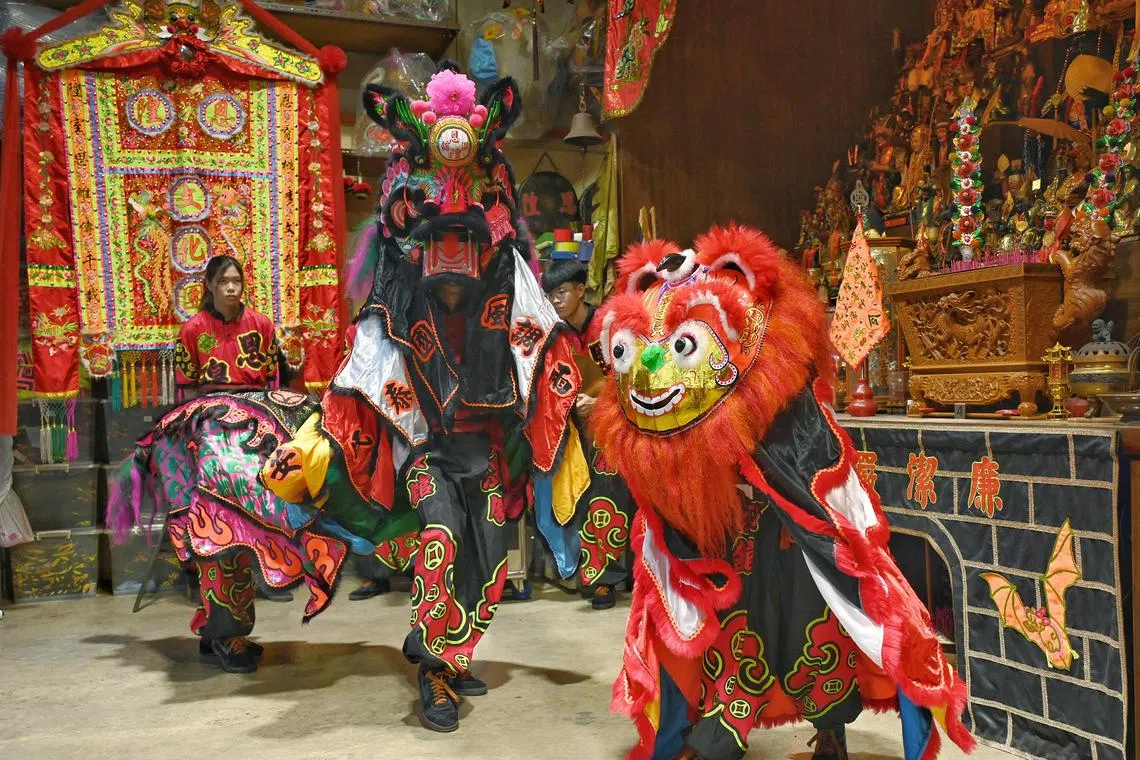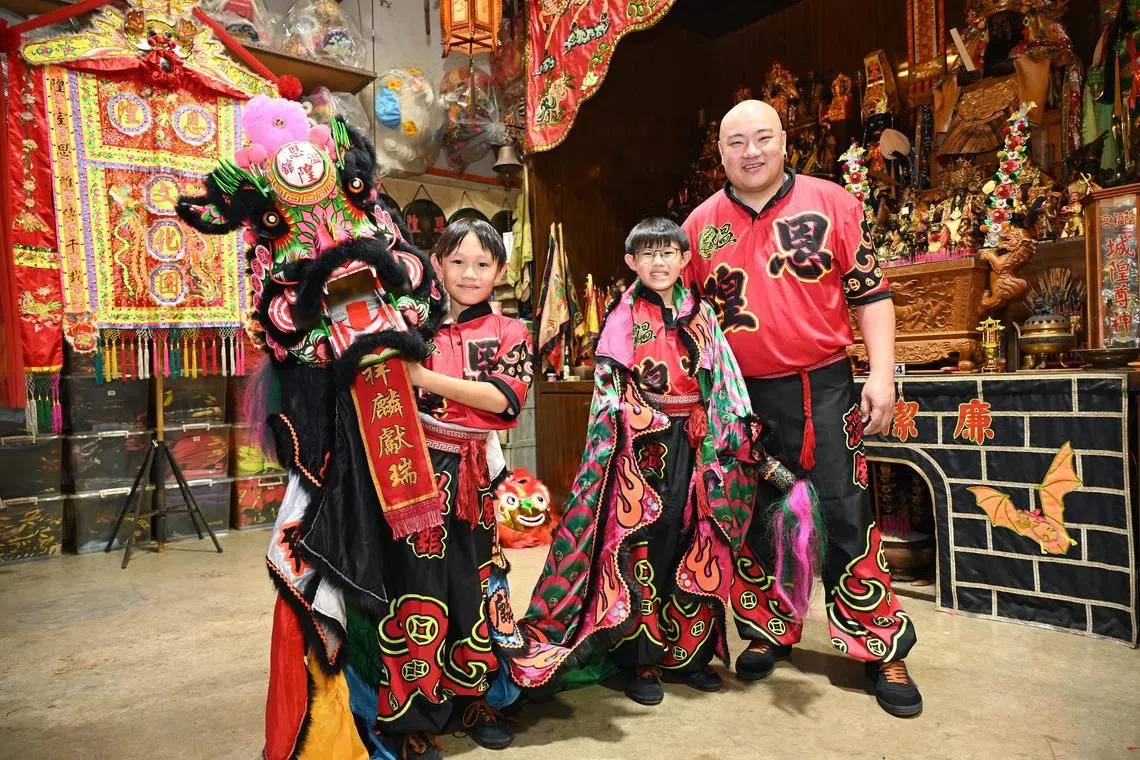Neither dragon nor lion – it’s the Hakka Qilin or Chinese unicorn dance
Sign up now: Get ST's newsletters delivered to your inbox

The qilin (left) is often accompanied by the fuguizi, a mythical flea, in performances.
ST PHOTO: DESMOND WEE
Follow topic:
SINGAPORE - Even as lion and dragon dances still dominate festive celebrations, a rarer traditional Chinese folk performance is quietly gaining traction here.
Mr Eugene Wan, 44, who helms the Yan Wong Cultural Troupe – the only professional troupe for the Hakka Qilin, or Chinese unicorn, dance in Singapore – is determined to preserve and promote the art form.
The Hakka Qilin dance, with a history of more than 450 years, embodies the spirit of the Hakka community, who developed the dance to preserve their tradition and express their cultural heritage.
The qilin, a mythical creature in Chinese folklore, takes centre stage in this spirited and agile dance, symbolising prosperity, good fortune and protection.
Unlike the Western unicorn, the Chinese qilin is often depicted as a hybrid creature with features of different animals, such as a dragon’s head and a deer’s body.
“I like being unique,” said Mr Wan, who is Cantonese but finds the qilin dance “mesmerising”.
“There were unicorn dances here in Singapore in the past, but many went extinct over time. I want to revive this.”
The unicorn dance is more difficult than the lion dance, he said. Dancers have to perform intricate footwork, spins and formations to mimic the majestic creature.
“With the lion, you can control its eyes, ears and head to show its expression. With the qilin, you can make use of only your body movements and imagination to bring it to life,” he said.
The music is distinctly different from that used in the lion dance as it is influenced by ancient Hakka melodies, and is meant to reflect the movements of the mythical creature.
It uses bigger cymbals measuring 45cm to 50cm wide, unlike the ones in lion dances that are only 28cm to 30cm wide.
Mr Wan, who is Singaporean, started learning the art in 1999. It took him three years to convince a qilin dance master from Hong Kong to accept him as a disciple, as he was neither from the same Hakka village nor Hakka himself.
He set up his troupe in 2015 and holds weekly practices in a factory space in Buroh Street in Jurong.
The troupe has 34 members aged between 10 and 44, including four female members.
“It was tough at the beginning. Many students and sponsors left me halfway, wondering if this qilin dance would really work,” he said.

(From left) Rayden and Jayden Chin with Eugene Wan from the Yan Wong Cultural Troupe.
ST PHOTO: DESMOND WEE
But his critics were silenced in 2017, when the troupe won the International Hakka Unicorn Championships held in Malaysia.
Mr Wan said his is the only professional qilin dance troupe in Singapore, though there may be others offering the dance.
It took him some time to raise awareness and interest among local organisations and individuals here too.
“They haven’t heard about the qilin, and those who saw it said it looks fierce, unlike the furry lion,” he said.
Mr Wan, whose troupe also offers the traditional lion dance, threw in the qilin dance for free for his lion dance clients in the first two years.

Mr Eugene Wan (third from right) and some members of the Yan Wong Cultural Troupe, which specialises in the Hakka qilin or unicorn dance.
ST PHOTO: DESMOND WEE
“By the third year, in 2017, we started seeing the demand and, today, we get more requests for our qilin than lion dance as it is more unique,” he said.
“The qilin is also fiercer and stronger than the lion and can better ward off evil and bad energy.”
Each qilin dance performance takes about 10 to 30 minutes, depending on the requirements, and prices start from $1,388.
It is sometimes accompanied by the fuguizi, a mythical flea, in performances. In comparison, a lion dance performance starts from around $888.
The youngest member of the troupe is 10-year-old Rayden Chin, a Primary 5 pupil from West Spring Primary School who joined the troupe in 2022.
“I like the music, and I enjoy doing the different stunts,” he said.
His 13-year-old brother Jayden, a Secondary 1 student from Bukit Panjang Government High School, is also in the troupe.
They were encouraged by their father, civil servant Ronny Chin, to pick up the art.
“They can help continue the culture,” said Mr Chin, a 41-year-old Hakka. “I also want them to learn the values, like discipline and respect, in the troupe.”
Today, the troupe is an annual highlight at the Sri Mariamman Temple in South Bridge Road during Chinese New Year.
It also performs at temple celebrations, Chinese and Hindu weddings, and other auspicious events throughout the year.
It will showcase and promote the intangible cultural heritage for the first time at the Sun Yat Sen Nanyang Memorial Hall this Chinese New Year, as part of the Wan Qing Festival of Spring Open House on Feb 18 at 1.45pm. Admission is free.

